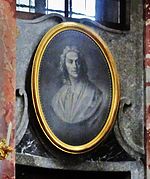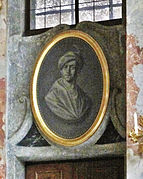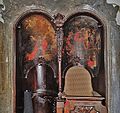Asamkirche (Munich)
The Asamkirche (officially St. Johann Nepomuk Church ) in Sendlinger Straße in Munich's old town was built from 1733 to 1746 by the Asam brothers ( Cosmas Damian Asam and Egid Quirin Asam ). It is considered to be one of the most important buildings of the two main representatives of the southern German late baroque . The Asam church is already on the threshold of the Rococo , but the typical main form of ornament , the rocaille , has not yet appeared.
Emergence
The church was originally to be built as a chapel for the Asam brothers, who are now based in Munich. After Egid Quirin Asam had succeeded in acquiring several pieces of land next to his house between 1729 and 1733 , he and his brother Cosmas Damian built the church of St. Johann Nepomuk there from 1733 . The foundation stone was laid in 1733 on the feast of St. Nepomuk by Prince Elector Maximilian Joseph of Bavaria ; the unfinished church was consecrated on May 1, 1746.
The church is a branch church of St. Peter .

architecture
The church was built without commission and as a private church for the higher glory of God and for the salvation of the builders. This also made it possible for the brothers to build independently of the client's ideas. The church is still shaped by the ideas of the Roman Baroque, while the first rococo church in Bavaria was completed in the year the foundation stone was laid with St. Anna im Lehel . Thanks to the artistic freedom he had gained, Egid Quirin Asam was able to look directly at the high altar through a window in his private house, like a monarch . Although the church was actually planned as a private church, the brothers had to make it publicly accessible after popular protests. Egid Quirin Asam designed the church as a confessional church for young people. It contains seven confessionals with allegorical representations.
The baroque facade is integrated into the row of houses on Sendlinger Straße and only swings outwards in a slightly convex manner.
The church was built in a very small space, the property measures only 22 by 8 m. All the more astonishing is the achievement of the two builders, who succeeded in harmoniously combining architecture , painting and sculpture in the two-story interior . In particular, the indirect lighting in the choir area is very successful: windows hidden behind the main cornice illuminate the Trinity figures effectively from behind. The main cornice itself seems to rise and fall due to its curved guidance.
The interior of the church is divided vertically into three sections, which increase in brightness from bottom to top. The lowest section with the benches for the church visitors is kept relatively dark and symbolizes the suffering of the world in its design. The second section above is white and bluish and reserved for the emperor. In 1742 the Bavarian Elector Karl Albrecht had achieved the dignity of Emperor. The top section with the indirectly and covertly illuminated ceiling painting is dedicated to God and eternity.
The choir was badly damaged in a bombing raid in 1944. It was only with the interior restoration from 1975 to 1983 that a hypothetical original appearance of the choir was established after studying the sources.
Facility
In the anteroom there is a confessional on both sides, above the apostle Peter on the left and St. Jerome as life-size stucco figures. St. Peter is shown with two keys for binding and loosening on earth and in heaven ( Matthew 16:19 EU ). To the left of the niche of St. Hieronymus can be seen the Zech epitaph from Ignaz Günther .
On the high altar there are four columns as a reference to the four Bernini columns above the Peter's tomb in St. Peter in Rome. First and foremost is God the Redeemer. Below the tabernacle is a relic of St. Johannes Nepomuk kept. Above the high altar there is a so-called mercy seat , depicted in three dimensions , on which God the Father is depicted with the triple papal tiara on his head. Compared to a usually very strictly structured Baroque parish church, the Asam Church because it is a private church some peculiarities to: The church is gewestet and not as usual faces east , that is, the high altar is located in the west. In addition, the crucifix opposite the pulpit is hung too low. In baroque churches this should hang higher than the pulpit so that the preacher must also look up to Jesus.
organ
The organ was built in 1982 by Wilhelm Stöberl . It has 16 registers on two manuals and a pedal with mechanical slide chests .
|
|
|
|||||||||||||||||||||||||||||||||||||||||||||
- Coupling : II / I, I / P, II / P.
Priest house and Asam house
The priest's house, adjoining the church to the north, is a five-storey narrow late baroque building with stuccoed window frames, ornamental apex stones and richly profiled cornices, probably built by Matthias Krinner, 1771–1773. To the south of the church is the Asamhaus .
Quotes
- The Bavarian author and cabaret artist Jörg Maurer describes the Asamkirche as follows: This building is, so to speak, a short version of the Bavarian essence ... This is where you can understand Bavaria most quickly. The Asam brothers built and designed the church in 1733, without ecclesiastical or secular clients, only for their own use ... This independent, solitary nature leads to the core of the Bavarian nature. For the Asam brothers, it was probably less about devotion and quiet contemplation, but more about representation, size, pathos, muscle play as well as lavish decoration and all that in a confined space ... You can really sink into yourself and pray quietly here, you can be less and more dazzled and amazed shake your head. ... After visiting the Asam Church you understand the locals a little better. Not a lot, but a little. That’s a start.
literature
- Richard Bauer , Gabriele Dischinger: Munich, Asamkirche (Schnell & Steiner Small Art Guide, 1277). Regensburg, 2005, ISBN 3-7954-4028-9 .
- Richard Bauer, Gabriele Dischinger (among others): St. Johann Nepomuk in the light of the sources - materials and discussions on the Asam Church in Munich . Munich, 1977
- Adolf Feulner: The Asam Church in Munich . Munich, 1932.
- Dorith Riedl: To two Asam churches. Munich, St. Johann Nepomuk. Straubing, Ursuline Convent Church. Dorith Riedl, Perfect Paperback 1979, ISBN 3-88341-001-2 .
- Erwin Schleich : The Asam Church in Munich - A contribution to the restoration in September 1977 . Stuttgart, 1977, ISBN 3-7984-0348-1 .
- Thomas Schauerte : The "Asamkirche" St. Johann Nepomuk in Munich and the memoria of Egid Quirin Asam , in: Münch, Birgit Ulrike / Marquard Herzog / Andreas Tacke (ed.): Artist graves . Genesis - Typology - Intention - Metamorphoses , Petersberg 2011, pp. 185–203, ISBN 978-3-86568-629-9
Web links
- Asamkirche on muenchen.de
Individual evidence
- ↑ Schnell, Art Guide No. 1277: Asamkirche St. Johann Nepomuk Munich , 9th edition, Verlag Schnell and Steiner Regensburg 2011, ISBN 978-3-7954-4028-2 .
- ^ Wilhelm Stöberl organ in the Asamkirche in Munich . www.organindex.de. Accessed May 14, 2018.
- ↑ Jörg Maurer, Bavaria for the trouser pocket - What travel guides conceal , Fischer Taschenbuch , Frankfurt am Main 2016, p. 7ff, ISBN 978-3596521012
Coordinates: 48 ° 8 ′ 6.4 ″ N , 11 ° 34 ′ 10.3 ″ E














